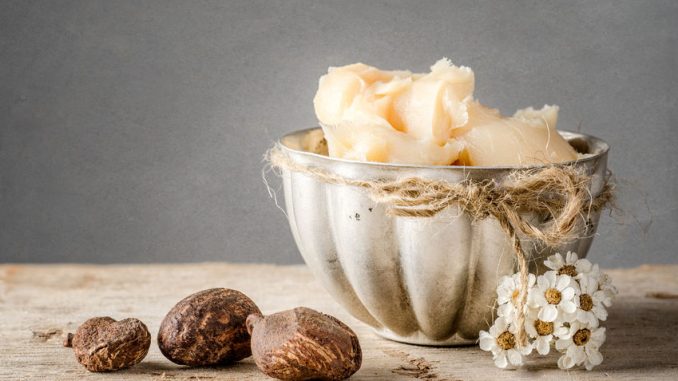
Shea butter is derived from the nut of an African trea, Butyrospermum parkii (Vitellaria paradoxa) and is one of the most ubiquitous ingredients in skin care, hair care and any other ‘care’ product you might care to think of. It is also an important food ingredient because the oil is used in the making of various foods in Africa such as masa. It is also used as a cocoa butter improver (CBI).
It is also known as karite butter.
The tree grows throughout west and central Africa and is grown wild in groves. Attempts to cultivate the tree have not been successful.
Extraction and Composition
Extraction Process
- Harvesting: Shea nuts are collected from the wild, primarily in West African countries.
- Drying: The nuts are sun-dried to reduce moisture content.
- Crushing and Roasting: The dried nuts are crushed and lightly roasted.
- Grinding and Boiling: The roasted nuts are ground into a paste and then boiled in water to separate the butter, which floats to the surface and is skimmed off.
- Refining: The raw shea butter can be refined to remove impurities, resulting in a more stable and versatile product.
Chemical Composition
- Fatty Acids: Shea butter is rich in stearic acid (35-45%) and oleic acid (40-55%), with smaller amounts of linoleic, palmitic, and arachidic acids.
- Triglycerides: It contains symmetrical triglycerides, which are similar to those in cocoa butter, making it highly compatible.
Functional Properties of Shea Butter
High Melting Point
- Melting Point: Shea butter has a melting point of around 31-39°C, close to that of cocoa butter (34-38°C). This makes it suitable for maintaining the solid form of chocolate at room temperature. It liquifies however at higher temperatures which makes it suitable in some food applications – hence the interest in it as a cocoa butter improver and as an oil in some frying applications.
Texture and Consistency
- Smooth Texture: The butter provides a smooth and creamy texture, enhancing the mouthfeel of chocolate.
- Firmness: It contributes to a firm texture, ensuring a good snap in chocolate bars.
Oxidative Stability
- Antioxidants: Shea butter contains natural antioxidants like vitamin E, which help in preventing oxidation and extending the shelf life of chocolate products.
Nutrition Facts
|
Amount Per |
| Calories 884 |
| % Daily Value* | |
| Total Fat 100 g | 153% |
| Saturated fat 47 g | 234% |
| Polyunsaturated fat 5 g | |
| Monounsaturated fat 44 g | |
| Cholesterol 0 mg | 0% |
| Sodium 0 mg | 0% |
| Total Carbohydrate 0 g | 0% |
| Dietary fiber 0 g | 0% |
| Sugar 0 g | |
| Protein 0 g | 0% |
| Vitamin A | 0% | Vitamin C | 0% |
| Calcium | 0% | Iron | 0% |
| Vitamin B6 | 0% | Cobalamin | 0% |
| Magnesium | 0% |
| *Per cent Daily Values are based on a 2,000 calorie diet. Your daily values may be higher or lower depending on your calorie needs. |
Skin Health Benefits
The healing properties can be put down to a myriad of components including several different fatty acids and plant sterols. The main ones are oleic, stearic, with smaller amounts of palmitic and linolenic acids. One of the main features of these oil-soluble fatty acids is that in the presence of alkalis such as soap they do not saponify meaning they do not become soap. The non-saponifiable fraction is highest in shea butter. The solid fat is extremely smooth with a pale yellow colour.
Shea butter also possesses interesting derivatives of cinnamic acid which is found in all sorts of important plants with health benefits. We also find catechins and other antioxidants which are common to green tea. Cinnamic acid esters are believed to prevent skin damage from ultraviolet radiation as well as soothing sunburn, rashes, eczema and dermatitis.
In a medical context, shea butter is valuable for treating and healing the skin. It is often used to smooth out wrinkles, sooth chapped skin, reduce irritation from razor cuts and ameliorate skin irritations. The butter is also used to treat chapped lips, flaky skin and reduce the abrasions of elbows and knees.
Shea butter contains vitamin A & vitamin E which helps protect the fatty acids.
Benefits of Shea Butter as a Cocoa Butter Improver
Enhancing Thermal Stability
- Thermal Stability: Shea butter’s high stearic acid content helps stabilize the polymorphic forms of cocoa butter. This stability is crucial for preventing the chocolate from melting easily in warmer conditions and maintaining its structure and appearance.
Improving Texture and Mouthfeel
- Creamy Mouthfeel: The oleic acid content in shea butter contributes to a creamy and smooth mouthfeel, which is desirable in chocolate products. This property enhances the sensory experience for consumers.
- Firm Snap: The symmetrical triglycerides in shea butter improve the firmness and snap of chocolate, providing a satisfying texture.
Preventing Bloom
- Fat Bloom Prevention: Fat bloom, a common issue in chocolate, occurs when cocoa butter crystallizes improperly, leading to a whitish film on the surface. The butter helps in controlling the crystallization process, reducing the likelihood of bloom and maintaining the chocolate’s visual appeal.
Cost Efficiency
- Cost Reduction: Shea butter is generally less expensive than cocoa butter. Using it as a CBI can help manufacturers reduce production costs without compromising the quality of the chocolate.
- Sustainable Sourcing: The butter is sustainably sourced from wild shea trees, supporting local economies and promoting environmental conservation. It has proved highly important in central and Western African agriculture by supporting diversity in specific areas.
Applications in Chocolate Production
Compound Chocolate
- Partial Replacement: Shea butter can be used as a partial replacement for cocoa butter in compound chocolate. This application helps maintain the desired texture and stability while reducing costs.
- Compatibility: Due to its similar melting profile and triglyceride composition, shea butter can be seamlessly incorporated into chocolate formulations.
Heat-Resistant Chocolate
- Heat Resistance: In regions with warmer climates, heat-resistant chocolate is highly desirable. Shea butter’s high melting point makes it an excellent ingredient for producing chocolates that remain solid and stable at higher temperatures.
Confectionery Coatings
- Glossy Finish: Shea butter can be used in confectionery coatings to provide a glossy finish and a firm texture. Its stable crystalline structure ensures that the coatings do not melt or develop bloom easily.
Comparison with Other Cocoa Butter Improvers
Shea Butter vs. Palm Oil Fractions
- Palm Oil Fractions: Commonly used as CBIs, they are rich in symmetrical triglycerides and provide good stability.
- Shea Butter: Offers a similar melting point to cocoa butter and provides a smoother, creamier texture, making it particularly suitable for premium chocolate products.
Shea Butter vs. Kokum Butter
- Kokum Butter: Known for its high melting point and non-greasy texture.
- Shea Butter: Provides a creamy mouthfeel and similar oxidative stability, making it a versatile option for various chocolate formulations.
Shea Butter vs. Illipe Butter
- Illipe Butter: Has a high melting point and is used in chocolates for warmer climates.
- Shea Butter: Offers similar benefits but with a smoother texture, enhancing the sensory qualities of chocolate.
Health and Environmental Considerations
Health Benefits
- Nutrient-Rich: It is rich in essential fatty acids, vitamins, and antioxidants, contributing to overall health. Its high stearic acid content is beneficial for maintaining healthy cholesterol levels.
- Hypoallergenic: Shea is generally well-tolerated and suitable for use in food products, including chocolate.
Sustainability
- Sustainable Harvesting: Shea butter is harvested from wild shea trees, which are not typically cultivated in plantations. This sustainable harvesting practice supports biodiversity and provides economic benefits to local communities.
- Environmental Impact: The shea tree, being naturally resilient and well-adapted to its environment, requires minimal agricultural inputs, reducing the environmental footprint of shea butter production.
Shea is an excellent cocoa butter improver, offering a range of benefits that enhance the quality and stability of chocolate products. Its high melting point, smooth texture, and oxidative stability make it a valuable ingredient in chocolate manufacturing. By incorporating this butter, manufacturers can improve thermal stability, prevent bloom, enhance texture, and achieve cost efficiencies without compromising on quality.
The butter stands out among other CBIs for its unique properties and compatibility with cocoa butter. Its health benefits and sustainable sourcing further add to its appeal, making it an ideal choice for modern chocolate production. Whether used in compound chocolate, heat-resistant formulations, or confectionery coatings, shea butter proves to be a versatile and beneficial component that meets the demands of both producers and consumers.
References
Abdul-Mumeen, I., Beauty, D., & Adam, A. (2019). Shea butter extraction technologies: Current status and future perspective. African Journal of Biochemistry Research, 13(2), pp. 9-22.
Honfo, F. G., Akissoe, N., Linnemann, A. R., Soumanou, M., & Van Boekel, M. A. (2014). Nutritional composition of shea products and chemical properties of shea butter: a review. Critical Reviews in Food Science and Nutrition, 54(5), pp. 673-686 (Article).

Leave a Reply